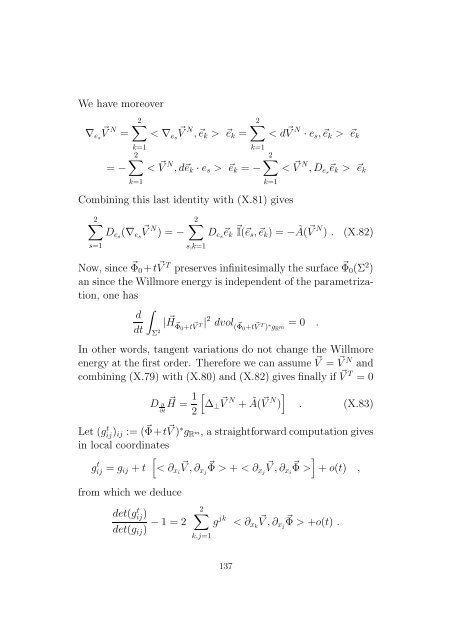Conformally Invariant Variational Problems. - SAM
Conformally Invariant Variational Problems. - SAM
Conformally Invariant Variational Problems. - SAM
You also want an ePaper? Increase the reach of your titles
YUMPU automatically turns print PDFs into web optimized ePapers that Google loves.
We have moreover<br />
∇ es<br />
⃗ V N =<br />
= −<br />
2∑<br />
< ∇ esV ⃗ N ,⃗e k > ⃗e k =<br />
k=1<br />
2∑<br />
< dV ⃗ N ·e s ,⃗e k > ⃗e k<br />
k=1<br />
2∑<br />
< V ⃗ N ,d⃗e k ·e s > ⃗e k = −<br />
k=1<br />
2∑<br />
< V ⃗ N ,D es ⃗e k > ⃗e k<br />
k=1<br />
Combining this last identity with (X.81) gives<br />
2∑<br />
D es (∇ esV ⃗ N ) = −<br />
s=1<br />
2∑<br />
s,k=1<br />
D es ⃗e k<br />
⃗ I(⃗es ,⃗e k ) = −Ã(⃗ V N ) . (X.82)<br />
Now, since Φ ⃗ 0 +tV ⃗ T preserves infinitesimallythe surface Φ ⃗ 0 (Σ 2 )<br />
an since the Willmoreenergy is independent of the parametrization,<br />
one has<br />
d<br />
dt<br />
∫<br />
Σ 2 | ⃗ H ⃗Φ0 +t ⃗ V T | 2 dvol ( ⃗ Φ0 +t ⃗ V T ) ∗ g R m = 0 .<br />
In other words, tangent variations do not change the Willmore<br />
energy at the first order. Therefore we can assume V ⃗ = V ⃗ N and<br />
combining (X.79) with (X.80) and (X.82) gives finally if V ⃗ T = 0<br />
D ∂<br />
⃗H = 1<br />
∂t 2<br />
[<br />
∆ ⊥<br />
⃗ V N +Ã(⃗ V N )<br />
]<br />
. (X.83)<br />
Let (gij t ) ij := ( Φ+t ⃗ V) ⃗ ∗ g R m, a straightforwardcomputationgives<br />
in local coordinates<br />
]<br />
gij t = g ij +t<br />
[< ∂ xiV,∂xj ⃗ Φ ⃗ > + < ∂xjV,∂xi ⃗ Φ ⃗ > +o(t) ,<br />
from which we deduce<br />
det(gij t ) 2∑<br />
det(g ij ) −1 = 2<br />
k,j=1<br />
g jk < ∂ xk<br />
⃗ V,∂xj ⃗ Φ > +o(t) .<br />
137
















